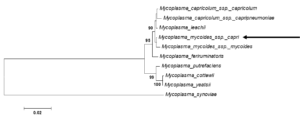Mycoplasma mycoides ssp. capri
(Edward, 1953; Freundt, 1955)
Etymology
Gr. n. mukes – fungus, Gr. neut. n. plasma – anything formed, N.L. neut. n. Mycoplasma – fungus form; G. n. mukes – fungus, L. suff. -oides – similar, N.L. neut. adj. mycoides – fungus-like; L. n. caper – a male goat, L. gen. n. capri – of the male goat
Taxonomy
Mycoplasmatales – Mycoplasmataceae – Mycoplasma – Mycoplasma mycoides ssp. capri (Mycoides cluster), closely related to Mycoplasma mycoides ssp. mycoides, Mycoplasma leachii, and Mycoplasma capricolum (16S rRNA gene sequence similarities – 99.59, 99.66, and 99.72%, respectively) (Fig. 1); Note, former Mycoplasma mycoides ssp. mycoides Large Colony (LC) has been reclassified as serotype of Mycoplasma mycoides ssp. capri
Type strain
PG3T (goat, Turkey, 1950), (Fig. 2, 16S rRNA gene sequence)
Genomes
40 completed (PG3T – Turkey; GM12 parent strain and 22 synthetics – USA; 95010, 7730 – both France; Ker.TCR.LT – India; Wi8079, G1313.94, G1283.94 – all Germany; My-1, My-5, My-325, My-18 – all Croatia; 83/93, 80/93, 171/93, 152/93 – all Spain; IVB-X – origin undefined; HN-A – China); 3 draft genomes (NCBI Genome deposit per 11/05/2024)
Cell morphology
spherical – coccoid
Colony morphology
fried egg morphology (Fig. 3)
Metabolism
fermentation of glucose; assimilation of glycerol; non-arginine-hydrolyzing, non-urea-hydrolyzing
Host
mainly goats, occasionally sheep and cattle
Habitat
respiratory tract, udder
Disease(s)
second main cause of Contagious Agalactia (CA) presenting mastitis with complete loss of milk production; septicemia with arthritis and pneumonia in kids; pleuropneumonia, mastitis, arthritis, kerato-conjunctivitis (MAKePS syndrome), and occasionally abortion in adult goats
Pathogenicity
known factors are capsular polysaccharides contributing to adhesion and enhancing resistance to phagocytosis, Ig protease (MIB-MIP system), production of hydrogen peroxide as a by-product of glycerol assimilation, biofilm formation
Epidemiology
widest geographic distribution of ruminant mycoplasmas occurring in all continents; transmission by milk (at suckling, by milkers’ hands, milking machine, bedding) or via aerosol; commonly introduced into herds by latently infected carrier animals
Diagnosis
cultivation and species identification by MALDI-ToF MS, serology or genetically; PCR; detection of antibodies using immunoassays such as ELISA and Western blotting
Fig. 1. Maximum likelihood tree showing the phylogenetic position of Mycoplasma mycoides ssp. capri PG3T within the Mycoides cluster of Mycoplasmataceae based on 16S rRNA gene sequences. The sequence of Mycoplasma synoviae WVU 1853T was used as out-group (Synoviae cluster). Numbers at nodes represent bootstrap confidence values (1000 replications). Only values > 80% are shown. Bar, number of substitutions per nucleotide position. Credits: Joachim Spergser (Vetmeduni Vienna)
CTGGCGGCATGCCTAATACATGCAAGTCGAACGGAGGTGCTTGCACCTCAGTGGCGAACGGGTGAGTAACACGTATCTAACCTACCTCATAGCGGGGGATAACTTTTGGAAACGAAAGATAATACCGCATGTAGATCTTATTATCGCATGAGAAAAGATCAAAAGAACCGTTTGGTTCACTATGAGATGGGGATGCGGCGTATTAGCTAGTAGGTGAGATAATAGCCCACCTAGGCGATGATACGTAGCCGAACTGAGAGGTTGATCGGCCACATTGGGACTGAGATACGGCCCAGACTCCTACGGGAGGCAGCAGTAGGGAATTTTTCACAATGGACGAAAGTCTGATGAAGCAATGCCGCGTGAGTGATGACGGCCTTCGGGTTGTAAAGCTCTGTTGTAAGGGAAGAAAAAATAAAGTAGGAAATGACTTTATCTTGACAGTACCTTACCAGAAAGCCACGGCTAACTATGTGCCAGCAGCCGCGGTAATACATAGGTGGCAAGCGTTATCCGGATTTATTGGGCGTATAGGGTGCGTAGGCGGTTTTGCAAGTTTGAGGTTAAAGTCCGGAGCTCAACTCCGGTTCGCCTTGAAAACTGTATTACTAGAATGCAAGAGAGGTAAGCGGAATTCCATGTGTAGCGGTGAAATGCGTAGATATATGGAAGAACACCTGTGGCGAAAGCGGCTTACTGGCTTGTTATTGACGCTGAGGCACGAAAGCGTGGGGAGCAAATAGGATTAGATACCCTAGTAGTCCACGCCGTAAACGATGAGTACTAAGTGTTGGGGTAACTCAGCGCTGCAGCTAACGCATTAAGTACTCCGCCTGAGTAGTATGCTCGCAAGAGTGAAACTCAAAGGAATTGACGGGGACCCGCACAAGTGGTGGAGCATGTGGTTTAATTCGAAGCAACACGAAGAACCTTACCAGGGCTTGACATCCAGTGCAAAGCTATAGAGATATAGTAGAGGTTAACATTGAGACAGGTGGTGCATGGTTGTCGTCAGTTCGTGCCGTGAGGTGTTGGGTTAAGTCCCGCAACGAACGCAACCCTTGTCGTTAGTTACTAACATTAAGTTGAGAACTCTAACGAGACTGCTAGTGTAAGCTAGAGGAAGGTGGGGATGACGTCAAATCATCATGCCCCTTATGTCCTGGGCTACACACGTGCTACAATGGCTGGTACAAAGAGTTGCAATCCTGTGAAGGGGAGCTAATCTCAAAAAACCAGTCTCAGTTCGGATTGAAGTCTGCAACTCGACTTCATGAAGCCGGAATCACTAGTAATCGCGAATCAGCTATGTCGCGGTGAATACGTTCTCGGGTCTTGTACACACCGCCCGTCACACCATGAGAGTTGGTAATACCAGAAGTAGGTAGCTTAACCGTTTGGAGAGCGCTTCCCAAGGTAGGACTAGCGATTGGGGTGAAGTCGTAACAAGGT
Fig. 2. 16S rRNA gene sequence of Mycoplasma mycoides ssp. capri PG3T (Accession number: NR_118794)Fig. 3. Large colonies with fried egg morphology of Mycoplasma mycoides ssp. capri PG3T on modified Hayflick’s agar after 3 days of incubation. Bar, 1 mm. Credits: Joachim Spergser (Vetmeduni Vienna)


